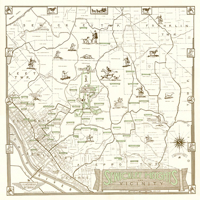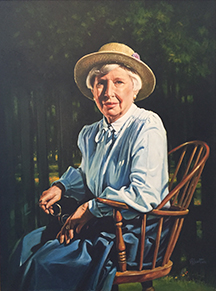
Morning Glory (B.G. Shields)
by George S. Gaadt
Founder and long-time Executive Director of the Sewickley Valley Historical Society B. G. Shields passed away on July 12, 2017. She will be greatly missed by all who knew her. The obituary below appeared in the Sewickley Herald, July 27, 2017:
"Betty G.Y. Shields, editor emeritus of the Sewickley Herald, died Wednesday, July 12, 2017, after a long illness in Lemont, Pa. She was 92. She was the wife of Daniel Leet Shields of Edgeworth, whom she married in 1953. He preceded her in death. B.G., as she was known to her friends and family, served as Herald editor from 1972 to 1987. She joined the Herald staff in 1970 as society editor. Before that, she contributed nature and history articles. In 1973, she called the first meeting of what became the Sewickley Valley Historical Society and is listed as a founding member. After retiring from the Herald, she became executive director of the society, serving until 2005 when she moved to Lemont. During the nation's bicentennial in 1976, she served as one of the tri-chairs of the Sewickley Valley Bicentennial Committee. She was a founding member of the Little Sewickley Creek Watershed Association. She was born Feb. 26, 1925, in Coffeyville, Kan., just over the border from Oklahoma, where her family, Butler County natives, worked the oil fields. Her parents were Frank S. Young and Meliss Gallaugher. She attended Butler High School and graduated in June 1942. She was a graduate of Miss Conley's School in East End, Pittsburgh, and attended the University of Pittsburgh, where she studied history. She was the mother of Daniel Leet Shields Jr., of Lemont, Pa., and the grandmother of William Francis Shields and Elizabeth Anthony Shields of Lemont. She was very fond of her daughter-in-law, Lynn Koval Shields. Paul Kramer of Butler was her stepfather. Her stepbrothers Sylvis R. and Richard T. Kramer and her stepsister Margaret Say Kramer all preceded her in death. A memorial service will be held in Sewickley at a future date. Burial will be private in Sewickley Cemetery. In lieu of flowers, Betty's request is that donations be made to the Salvation Army and Sewickley Valley Historical Society."
The Sewickley Valley
The Sewickley Valley is beautiful in situation and rich in history. Because the Valley is in a major corridor that led westward, the area was witness to momentous events in the last half of the 18th century: the French and Indian War, Pontiac’s Rebellion and the American Revolution.
After the Revolution, the American Indians’ title to the land north of the Ohio River (including the Sewickley Valley) was extinguished by treaties and appropriated for the redemption of depreciation certificates, given to Pennsylvania veterans in lieu of money for services during the war. Surveys were conducted in 1785, and the land was offered for sale, most of which was snapped up by speculators. Not until the last Indian resistance was crushed by General Anthony Wayne and his Legion at the Battle of Fallen Timbers in 1794 was it safe to settle in the Sewickley Valley.
The first settlers arrived here in the late 1790s. Most of the early residents were farmers, but inns and taverns soon sprang up to accommodate increasing traffic heading westward. Flatboats and keelboats, and after 1811, steamboats, crowded the Ohio River. In time, daily stagecoach service was added on the already busy Beaver Road between Pittsburgh and Beaver.
Respectability and a sense of community came to the Valley in 1837, when James and Mary Olver moved their school for young ladies from Pittsburgh to what was known as Sewickley Bottom, naming it the Edgeworth Female Seminary; and in 1838, when John B. Champ and William M. Nevin founded an academy for boys, today the coeducational Sewickley Academy. Students from up and down the river were soon seeking a genteel education in Sewickleyville, as the residents decided to call their settlement in 1840.
The pace quickened with the arrival of the railroad in 1851, transforming what was a sparsely settled rural community into a very desirable suburb of the City of Pittsburgh. Eventually there were stations at Haysville, Glen Osborne, Sewickley, Roseburg, Quaker Valley, Edgeworth, Shields and Leetsdale. By 1910 there were fifty commuter trains a day, one leaving about every ten minutes.
On July 6, 1853, the Borough of Sewickley was incorporated. Osborne Borough followed in 1883, and Edgeworth and Leetsdale in 1904.
The heights above Sewickley remained undeveloped. Cochran Fleming purchased much of this land in 1881, attempting to develop a dairy farm, but the operation went bankrupt. Fleming’s 2200 acres were purchased for $38 an acre by four Pittsburgh businessmen, who retained acreage for themselves and sold some to carefully chosen men of wealth. Before long, magnificent houses and attendant farms covered the hilltops, tenanted by some of America’s wealthiest families. The Heights became even more attractive when Allegheny Country Club moved to the Heights in 1902. As roads were improved and the automobile made access more convenient, some of the great houses were converted to year-round use, and a permanent community grew with the country club as its focus. In 1935, Sewickley Heights Borough was formed.
In 1911, the Sewickley-Coraopolis Bridge was completed, uniting the north and south banks of the Ohio River and rendering the three local ferries obsolete. A second bridge replaced the original in 1981. In 1929, the tracks of the Pennsylvania Railroad were moved closer to the river, making way for the construction of Ohio River Boulevard, completed as far as Sewickley in 1934. Increased reliance on the automobile eventually spelled the end for passenger rail service, which ended in 1989. Sewickley was conveniently near the Pittsburgh Airport when it was constructed after World War II, ensuring a bright future.
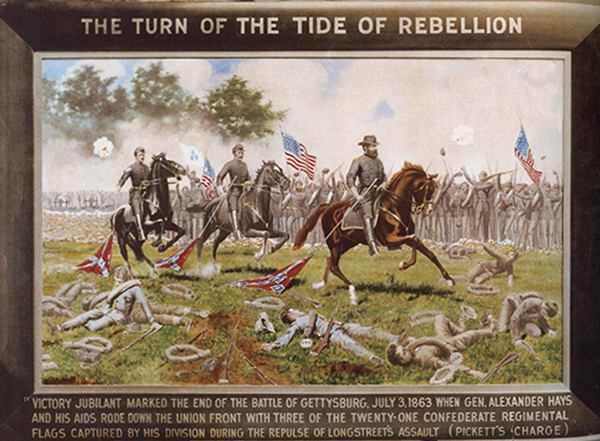
Following Pickett's Charge at Gettysburg, Gen. Alexander Hays famously dragged Confederate battle flags in front of his troops. Aide-de-camp Lt. David Shields, left, commissioned this painting c. 1910. After his death in 1944, his sister gave away the painting, and it has not been seen since. This image is from Betty G. Y. Shields, daughter-in-law of David's brother, Thomas Shields. Another brother, William, was killed in the Battle of the Chancellorsville.
Below is a picture of David Shields, known as Captain Dave, from the Sewickley Valley Bicentennial Collection. The picture is described by B. G. Shields as follows:
The scene is Gettysburg, the third day immediately after Pickett's Charge. The tide of rebellions has been repelled and twelve regiments of Hays' Division have captured 2,600 prisoners and 21 stands of colors. "General Hays took a Rebel flag captured by a captain of the 126th N. Y. Volunteers and two of his staff, Corts and Shields, each with a captured flag, rode down in front of his command, and in the rear, trailing the Rebel colors in the dust, and amid the deafening shouts and cheers of the men who for a moment forgot the terrible battle scene and thought of the glory of their victory."
This is a newspaper description of the Flag Incident at Gettysburg immediately after Pickett's Charge in which the 19-year-old David Shields took part. It was an episode that would remain forever afterwards in the memory of a youth whose going to war was strongly opposed by his parents. Their opposition was not political or conscientious, but Dave was only 17, with an older brother already in the conflict.
Following his beloved general friend, Capt. Dave reminisced on the flag incident many years later. In the book Life and Letters of General Alexander Hays: "These men (the Rebels), enemies at that, could but admire so intrepid a commander as General Hays, though at the time feeling most keenly the insult of their colors. At the time of this most exhilarating ride the bullets of the sullen and defiant enemy came sputtering about us and overhead. These were the only moments in the action I never felt fear. My horse seemed to be off the ground traveling through the air. I felt though a shot as large as a barrel should hit me in the back it would be with no more effect than shooting into a fog bank."
Shields followed his General on and on after Gettysburg and eventually was wounded, quite severely, at Morton's Ford, Virginia, in early February, 1864. The General's wife personally nursed Dave at the field hospital. As soon as health would permit, he returned home to spend the rest of his life in the Valley. At 20, he had seen more battles than he had years.
His military bearing and his expert horsemanship were remarkable and he became a familiar figure upon his steeds, always a Morgan horse, all named Chief, as he rode the roads and fields of the Valley. As the years passed by, one shoulder sagged a little, the hair whitened, but his blue eyes remained keen. He devoted much of his time to the affairs of the G. A. R. correspondence with the U. S. government in an attempt to set the record straight on the important part his old General had played in the Battle of Gettysburg.
Frank and outspoken Dave, who remained a bachelor, was a popular figure in Sewickley, dependable but not always predictable. Meaning to honor him on his 80th birthday, the local Legion post invited him to say a few words on the occasion. The Captain explained in no uncertain terms that they had little right to call themselves soldiers. "What could you know of war when you fought the enemy from trenches 20 miles away. Where was your hand-to-hand combat?" Instead of resentment, the remarks evoked a round of applause. The vets showed their regard for the old soldier by accompanying his body to Gettysburg National Cemetery, where he was buried at the age of 93. Nearby, a marker with Theodore O'Hara's well-know words serve as the epitaph of all the Boys in Blue:
On Fame's eternal camping-ground
Their silent tents are spread,
And Glory guards, with solemn round,
The bivouac of the Dead.
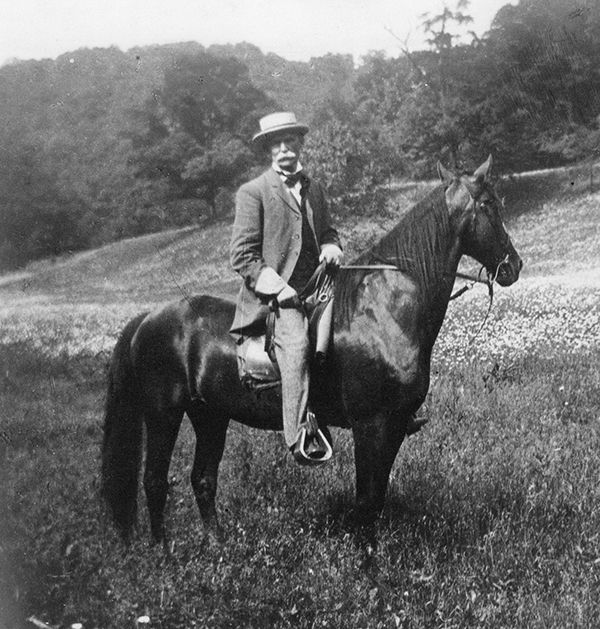
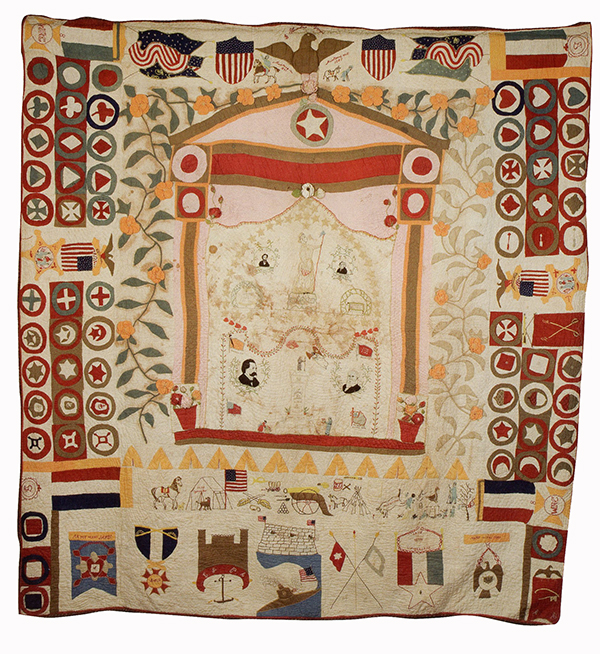
Quilt, cotton with embroidery and applique, attributed to Sarah Bright Anderson Lea, c. 1890. Collection: Sewickley Valley Historical Society
This quilt was probably made in the Fineview section of Allegheny City, sometime between 1889 and 1892. Sarah Bright Anderson Lea was the wife of Benjamin Franklin Lea, some ten years her junior, who served in the Union Army between 1863 and 1865, as a guard and later as a cook at Camp Reynolds in Pittsburgh. Mr. Lea, a substitute for an unknown draftee, was a private when he mustered out in 1865. He joined G. A. R. Post No. 162 in Allegheny City on January 19, 1889, and in the period 1890-1893 was active in the organization, serving as Post Surgeon in 1891 and being nominated for positions of Junior Vice Commander and Officer of the Day in 1893 and 1894, respectively. The quilt's design and symbols indicate that it was made in connection with a celebration or commemoration sponsored by the G. A. R. Sara Lea died January 27, 1918, and her husband died four weeks later.
Sarah Lea Nearing, Sara and Benjamin Lea's granddaughter, inherited the quilt. In 1975, Mrs. Nearing and her family, planning to move to Florida, decided that they wished the quilt to remain in the North and offered it to the Sewickley Bicentennial Committee be used as a feature of the local celebration in 1976; the acquisitions of the Bicentennial Committee subsequently formed the foundation of the Sewickley Valley Historical Society's collection. The quilt was exhibited during Sewickley's Sesquicentennial in 1990, at a 2002 folk art exhibition at the Heinz History Center and at an exhibition at the Westmoreland Museum of American Art in 2007 entitled "Made in Pennsylvania: A Folk Art Tradition."
The following, excerpted from an article by B. G. Y. Shields, appeared in the Sewickley Herald, March 24, 1976.
Quilt, means to communicate Civil War experiences
Since the beginning of time, people have been leaving traces behind. Some people erect castles to attest to their greatness; others create canvases which tell the world of their mastery with brushes and paint. More modest, of course, is folk art, but no less loving care goes into the tracings. It is man’s desire to communicate experiences with generations to follow.
Such must have been the case when Sarah Bright Anderson Lea sat beside the bed of her convalescing husband just home from the Civil War. As Ben recounted his experiences by means of sketches, Sarah proceeded to stitch, so his story would be told in the only art medium she knew, quilts.
First, “we will put the glorious symbol of peace,” we can almost hear her saying. “Do you think you can make Lincoln and Davis and Grant and Lee?” he would ask.
Whiling away the tedious hours until he was back on his feet, he would sketch and she would sew.
What developed is a remarkable story of the activities of camp life … tents, the headquarters, horses, cannons, the campfire, soldiers bagging a goose for dinner, even the picture of uniforms hung on a tree while the soldier was away for a dip in the stream.
Benjamin Franklin Lea must have agreed that “war is hell” because one scene shows the soldier going off to war proudly on his beautiful steed only to return on a donkey. For a touch of whimsy and authenticity, embroidered on the donkey is that universal scourge of war, the louse.
As a border, the Leas decided to incorporate tall the regimental patches of the G. A. R., but there is much, much more, even the Monitor and the Merrimack. About the only thing one can’t find in this historical review in stitchery is a replica of the Stars and Bars.
The reverse side of the quilt does honor to the Stars and Stripes, the grand symbol which Benjamin Franklin Lea revered. There are 44 stars, two obviously added later. Stitched finely into one of the white stripes is this message, “Collections from July 1752 to August 1890.” The later date is a clue that the last stars stand for Wyoming and Idaho, which were taken into the Union in July 1890.
Fortunately for posterity, this family heirloom fell into the right hands. While its owner, Mrs. Sara Lea Nearing, admits the now-faded banner has never been a touch-me-not, still it was always appreciated and regarded as a family treasure. One can imagine it held a fascination for her son Harvey who used to put it down on the floor on rainy days and ponder the battle scenes and the meaning of the symbolism. The quilt served as a course in American history although young Harvey didn’t realize it at the time.
As her grandmother pieced the story together, so has Mrs. Sara Nearing pieced together some of the family history that caused her grandfather to serve in the Union forces.
This article appeared in the October 2014 issue of Signals in conjunction with a program by David N. McKnight entitled "James Laughlin IV and the New Directions Publishing Company."
The Laughlin name is well known in the Sewickley Valley, but it is important to note that there are several different families involved. Let us distinguish among them.
First of all, who was James Laughlin IV, the subject of our lecture this month?
The great-grandfather of James Laughlin IV, James Laughlin I (1806-1882), was a partner of Benjamin Franklin Jones (1826-1903) in the famous firm, Jones & Laughlin Steel. Laughlin was born in Ireland and remained there until age twenty, when, after the death of his mother, he and his father emigrated to America and joined his elder brother Alexander (1790-1867), who had come to Pittsburgh in 1819. Upon arrival, James entered into a partnership with his brother Alexander in a provisioning and pork packing house in Pittsburgh and Evansville, Indiana. This partnership was dissolved in 1835, and James continued in business with a new partner.
In 1837, James married Ann McCully Irwin (1813-1892), and they had a daughter and four sons: Henry A. (1838-1922), Irwin B. (1840-1871), George A. (1842-1908), Elizabeth Irwin (1844-1929) and James II (1847-1919). James Laughlin I was one of the organizers of the Fifth Avenue Savings Bank, later called the Pittsburgh Trust Company and, later, the First National Bank of Pittsburgh, which was the first national bank in Allegheny County. James Laughlin I became President of that bank.
In the 1850s, James Laughlin I retired from the provision business and turned his attention to the manufacture of iron. Benjamin Franklin Jones was partners with Bernard and John Lauth in a small mill in Pittsburgh called the American Iron Works. In 1854, Laughlin joined the group and bought out the Lauths’ interests. In 1861, James Laughlin I and his sons Henry and Irwin and B. F. Jones and his brothers, George and Thomas, formed the firm of Jones & Laughlin, which would later use Lake Superior ore and Connellsville coal to make the finest iron and steel.
James Laughlin II, fourth son of James Laughlin I and Ann Irwin, married Sidney Page (1848-1925). They had sons named James Laughlin III and Henry Hughart Laughlin. Henry Hughart Laughlin married Marjorie Rea, and they were the parents of James Laughlin IV, named after his uncle, James Laughlin III.
Who, then, was Alexander Laughlin, Jr. (1844-1881), who married the eldest daughter of B. F. Jones, and who, with his family, became the second generation of the Joneses to live at Franklin Farm, the family estate on Sewickley Heights?
Benjamin Franklin Jones married Mary McMasters (1829-1911) on May 21, 1850, and they had four children: Mary Franklin (1851-1931), Elizabeth McMasters (1862-1939), Alice (1866-1939) and Benjamin Franklin Jones, Jr. (1868-1928). Mary married Alexander Laughlin, Jr., in the 1860s. He was the son of James Laughlin’s brother Alexander Laughlin (1790-1867), mentioned above, and his wife, Mary Ann Bailey. Therefore, this Alexander Laughlin, Jr., was the nephew of B. F. Jones’ partner in the steel business, James Laughlin.
Finally, who were the Alexander Laughlins who lived where the Sewickley Academy faculty housing is located today in a house called Linganore; who constructed a handsome library in Ambridge, Pennsylvania, in memory of their son, Alexander Laughlin, Jr.; and who were instrumental in the founding of the institution today known as the Mary and Alexander Laughlin Children’s Center, located in Sewickley?
This Alexander Laughlin was born in 1866 in Wheeling, West Virginia, son of Alexander and Lisette Lamping Laughlin. He was educated in Wheeling schools, the Hill School and attended Washington and Jefferson College. In 1883, he began his career as a clerk at the Laughlin Nail Company of Wheeling, later working at the Junction Iron Company, also in Wheeling.
In 1887, he married Mary Bushnell Mead, and they had one son, Alexander Laughlin, Jr. (1889-1926). In that same year, Laughlin decided to go into business for himself and came to Pittsburgh, where he engaged in the design and construction of furnaces in iron and steel mills, trading as Alexander Laughlin & Company. His firm went on to design and build many of the largest steel plants in the United States.
In 1904, Laughlin purchased the Pittsburgh Steel Construction Company in Allegheny, Pennsylvania, and shortly thereafter purchased land in Economy (later Ambridge), where he built a modern structural steel plant. This operation was discontinued in 1909 and sold to the Central Tube Company, which had been organized by Mr. Laughlin. In time, five pipe mills would be constructed in Ambridge. He was also later involved with the Verona Tool Works.
The Laughlins moved to Sewickley in 1891, not long after their arrival in Pittsburgh. Mrs. Laughlin founded the Sewickley Fresh Air Home in 1901, a structure consisting of twenty five rooms on Big Sewickley Creek Road in Fair Oaks intended to provide “for needy children from Pittsburgh’s tenement neighborhoods,” with an emphasis on “fresh air, nourishing food and plenty of healthy exercise.” Later, the home served crippled and convalescent children. The Fresh Air Home continued to offer services into the 1950s. When Mary Mead Laughlin died in 1953, leaving money for the continued support of children’s services, the home was combined with the Child Counseling Center of Sewickley Valley (sponsored by the Child health Association of Sewickley) to form the Laughlin Children’s Center, which opened in 1956.
Agnes L. Ellis’s local history, Lights and Shadows of Sewickley Life; or, Memories of Sweet Valley, was first published in 1891 and greatly expanded in 1893. Her explanation for the origin of the Sewickley name has been cited by local historians ever since. On page 36 of the second edition she states, "I remember seeing a letter, that had travelled some hundreds of miles, directed to 'Sweet Valley or Switleyville.' It came all right with its queer directions, and 'Sweet Valley' has always seemed since then to tell the story of the place….."
On page 39 of the same edition she expands on this:
"The Indians called the water Seweekly that ran from the maple trees, meaning sweet water, and for a time the trees were called by the old residents 'Seweekly trees.' Gradually the streams were called Seweekly, and we now know them as Big Sewickley and Little Sewickley Creeks. The name 'Sewickleyville' was decided on in the autumn of 1840. Previously, 'Contention,' 'Fifetown,' and 'Bowling Green' were among the names by which it was called."
Although Ellis’s theories are picturesque, the village was probably named for a sub-tribe of the Shawnee Indians, the Asswikales. At least six other locations and streams in Western Pennsylvania had previously been named for these Native Americans, some of them well over a hundred years before the name “Sewickleyville” was adopted in 1840. The Handbook of American Indians North of Mexico (Frederick Webb Hodges, editor, Smithsonian Institution, Bureau of American Ethnology, Bulletin 30, 1910, vol. 2, p. 516) provides the most detailed information regarding the Asswikales tribe:
"Sewickley. A former village of the Shawnee, called by the early Indian traders Asswikales (see Hathawekela), later shortened to Swickleys, situated on the n. side of the Allegheny r., about 12 m. above Pittsburg, near the site of Springdale, Allegheny co., Pa. In the notes given in the table of distances by James Le Tort before the Pennsylvania Council (1731), he speaks of 50 families of these Asswikales “lately from Carolina to Potowmack, & from thence thither; making 100 men; Aqueloma, their Chief.” ... These Shawnee, a short time before, had settled on the w. branches of the Susquehanna, whence they moved to the Conemaugh, then down the Kiskiminetas to the Allegheny.... A number of these Shawnee were located along the streams in Westmoreland co., hence the name for Sewickley cr., Sewickley settlement, etc. The town on the Allegheny is noted on Bonnecamp’s map of 1749 as “Ancien Village des Chaouanons”, through which place Celeron de Bienville passed in that year.... Sewickly’s old T.—Evans map, 1755. Sewicklys Old Town.—Scull map, 1770; Pownall map, 1776. Village des Chaouanons.—Bonnecamp map, 1749."
The “Hathawekela” reference appears in vol. 1, p. 536, of the same handbook:
"Hathawekela. A principal division of the Shawnee, the name of which is of uncertain etymology. They emigrated from the S. about 1697, together with other Shawnee bands, and settled with them, partly on Susquehanna and partly on Allegheny r., Pa., where they are mentioned in 1731. Sewickley, Pa., probably takes its name from them...."
A History of the Presbyterian Church of Sewickley, Pennsylvania, prepared by a Committee of the Congregation in 1914, contains a chapter by Franklin Taylor Nevin entitled “Sewickley: A Historical Sketch.” On page 80, he states:
"Charles A. Hanna, in his exhaustive study of the early history of this region, The Wilderness Trail (published in 1911), says (vol. i, page 298): 'The name of the Asswikales Indians who came from South Carolina has been preserved to the present day under the form of Sewickley, a name now applied to two creeks, forty miles apart, one on the east and the other on the west side of Pittsburgh.' Elsewhere, he gives the following variants of the tribal name, some of which result from differences in the native dialects: Assekales, Asswekalaes, Shaweygilas, and Shaweygiras. The oldest form, he says, appears to have been Sawakola or Sawolki, derived from [the] two Indian words sawi, raccoon, and ukli, town."
Nevin goes on to say:
"Be the derivation of the name as it may, the earliest mention of Sewickley as the name of a locality seems to have been in the form “Sewichly Old Town,” in a grant from the Six Nations to George Croghan, dated 1749....
"In an interesting letter, now in the possession of Mr. Gilbert A. Hays, which is dated at Pittsburgh, 31st December 1767, and written by one John Campbell, an Indian trader, reference is made for the first time, so far as is now known, to the Sewickley lying on the north bank of the Ohio River. He says: 'Four Men that I sent off in a Cannoe and who had gone but a short Distance below the Point had nearly been overset, and with great Difficulty returned without daring to attempt the Recovery of the Batteau. She was seen passing the Sewicly Bottom (a Place about 12 or 14 miles off,) that Night and was sound.'
"The locality is named again, as early as the year 1779, when the Delaware Indians, in gratitude for his treatment of them, offered to Colonel George Morgan, the first Indian agent at Fort Pitt, as a free gift, a strip of land extending roughly from what is now Haysville to Legionville and back to the tops of the highest hills, including the Sewickley Bottom, a tract possibly six miles long by three wide. This gift Colonel Morgan declined to accept in return for “merely doing his duty,” as he expressed it."
Another early reference to the immediate area appeared twenty years before the name “Sewickleyville” was adopted. The Blaine family had built a substantial home along Big Sewickley Creek, above the Ohio River. Gail Hamilton [Dodge] writes in her 1895 Biography of James G. Blaine:
"Here lived and prospered James Blaine and here his son Ephraim Lyon [Blaine] brought his bride. A letter of 1820 from one of his friends says playfully, if somewhat incoherently, 'The Duke of Sewickley, Late Middlesex, it is said, will take a wife from the backwoods, and has selected Maria Gillespie as the object.'"
James G[illespie] Blaine, son of Ephraim and Maria, was to become one of the most prominent politicians in America, serving as Speaker of the U. S. House of Representatives from 1869-75, as Secretary of State in 1881 and 1889-92, and as the Republican candidate for the Presidency in 1884.
From the best documented evidence, one must conclude that the name Sewickley was derived from an Indian word for a Native American tribe or the native raccoon. After 100 years, it may seem misguided to reject Agnes Ellis’s reference to Sewickley as “Sweetwater.” Today, however, many consider another of the early proposed names for the town — “Contention” — most appropriate of all.
Agnes Ellis’s Lights and Shadows of Sewickley Life and Franklin T. Nevin’s The Village of Sewickley (which also contains the historical sketch found in the church history) are available in $20.00 reprint editions from the Historical Society. See our web site, www.sewickleyhistory.org, email us at This email address is being protected from spambots. You need JavaScript enabled to view it., or call 412-741-5315 for details.
You may have noticed that the Sewickley Valley Historical Society has recently installed blue and yellow signs in a number of Sewickley Valley boroughs to show the location of a north south line that runs through our lives. This was the first mark placed upon these lands by the Europeans, two hundred and twenty-five years ago in 1785. Here is the story.
Read more: Depreciation Lands
Sewickley Valley:
Traditional name for land extending from Glenfield to Beaver County line at Big Sewickley Creek.
Quaker Valley:
A designation that arose during the 1960s when the Commonwealth of Pennsylvania mandated larger school districts. The name is a compromise that harks back to the Quaker roots of one of the pioneer families - the Ways - and the fact that there was at one time a railroad station called Quaker Valley. Quaker Valley station was located at the foot of Academy Avenue on the property of the Way Family.
The Name Sewickley:
Citizens of the town met to consider a name for their town in 1840, choosing the name Sewickleyville over Fifetown, Contention, Devil's Race Track and Dogtown. The town was incorporated as Sewickley in 1853.
Name Origin:
History records a tribe of Indians called Assiwikales. Popular version is that Seweekly is an Indian name for the sap of the maple trees that were abundant in the rich virgin forest - thus, Sweetwater.
Influences On History:
- The Great Beaver Road - Conestoga wagons, etc.
- The Ohio River - Steamboats and river captains
- The Railroad - Pennsylvania R. R.'s main line west, July 4, 1851
- Migration of iron and steel families from Pittsburgh
- Sewickley Bridge, 1911
- Ohio River Boulevard - Opened December 15, 1934
- Greater Pittsburgh Airport after World War II
Visitors & Residents
- George Washington, 1753
- Col. Bouquet, 1764
- Gen. Anthony Wayne, 1792
- Gen. Zachary Taylor, 1848
- Ethelbert Nevin (1862-1901) - Native Son
- Willa Cather - Visitor, 1900
- William Howard Taft - Visitor
- Mary Roberts Rinehart (1876-1958) - Resident
- Estate Families - Jones, Laughlin, Byers, Oliver, Boggs, Buhl
Prepared by Sewickley Valley Historical Society, 2001





